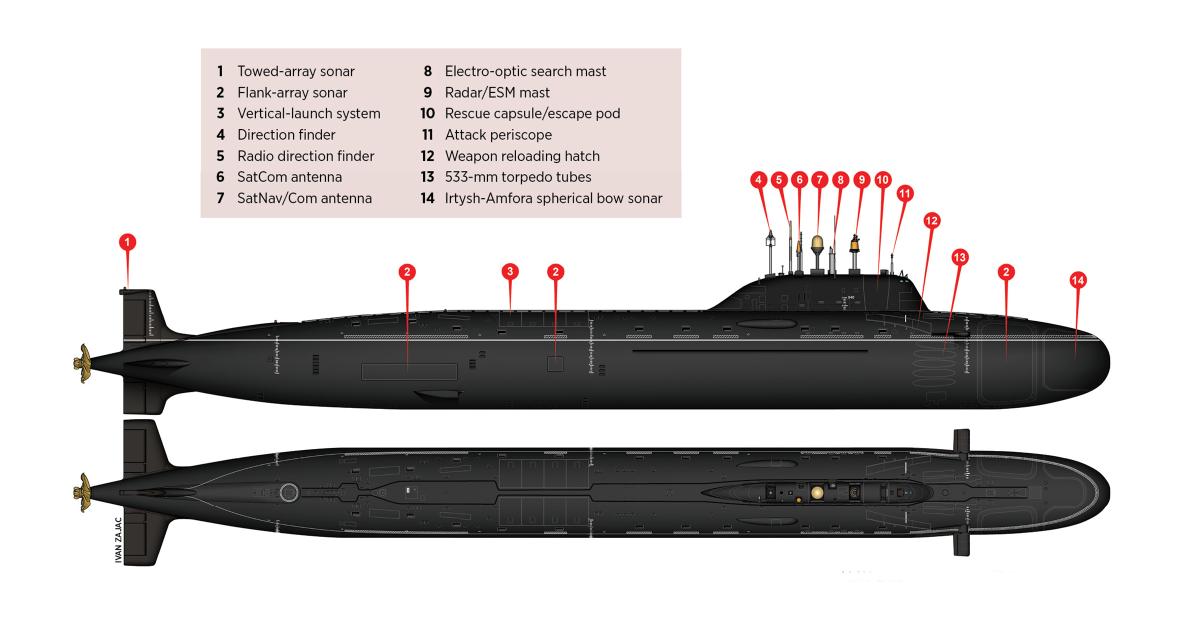Submarines have long been an important priority for the Russian armed forces, as capital ships of the Russian Navy—and its Soviet predecessor. In the 1980s, the Soviet Union sought a design capable of competing with the most advanced U.S. and NATO attack submarines well into the future. Known alternatively as the Severodvinsk, Yasen, or sometimes Graney class of nuclear-powered guided-missile submarines (SSGNs), Project 885’s design plans were reportedly well under way in the Soviet Union by the early 1980s.
Despite the end of the Cold War, construction on the first submarine of the class, the Severodvinsk, commenced in late 1993 at Sevmash shipyard in the northern city of Severodvinsk. But work on the 13,800-ton (submerged displacement), 390-foot submarine soon slowed to a crawl because of financial challenges. Years passed before efforts could resume in earnest, and it was not until June 2010 that enough work had been completed for the submarine to be launched. Sea trials finally began in 2011, and the Severodvinsk was commissioned on 17 January 2014, more than two decades after she was first laid down.
The Project 885 boat is a fourth-generation submarine designed to carry out a wide variety of undersea operations, including antisubmarine, antiship, and land-attack missions.
The SSGN is thought to make extensive use of automation, requiring a comparatively small crew of as few as 60 to 80 sailors (sources disagree). It is fitted with an Irtysh-Amfora spherical bow sonar, along with flank-array and towed-array systems. To make room for the sonar systems, the Severodvinsk’s torpedo tubes are positioned behind the forward sonar arrays, farther back than is typical for Russian submarines. Although earlier sources indicated that four 533-mm and four 650-mm torpedo tubes are carried, most reports now assess that the submarine is fitted with ten 533-mm torpedo tubes, with five on either side of the boat. Russian media indicate that in addition to mines and older types of 533-mm torpedoes, the submarine can likely carry the new Futlyar torpedo, which underwent sea trials during 2017 and reportedly incorporates improved homing systems and impressive underwater operating characteristics.
The SSGN also carries an 8-tube vertical-launch system thought to be capable of launching 32 3M-55 Oniks (SS-N-26) antiship missiles. Alternatively, it could carry 40 missiles from the Kalibr family of weapons: The antiship (3M-54/SS-N-27 Sizzler), land-attack (3M-14/SS-N-30), and 91R antisubmarine missiles reportedly can all be launched from the platform. A nuclear-armed land-attack variant may also exist.
After the completion of Severodvinsk, construction appears to have transitioned from the original Project 885 design to an improved version, Project 885M. In mid-2019, Russian media was reporting that the first Project 885M boat, the Kazan, was undergoing sea trials, and five additional submarines of the class were in various stages of construction. The third unit, the Novosibirski, is thought to have been launched in December 2019, and construction reportedly began on the seventh submarine in the summer of 2017. Two additional units were ordered in 2019, with construction expected to start on the eighth and ninth units sometime in 2020.



